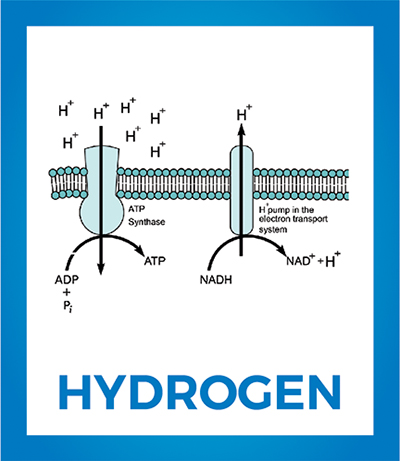For January, it’s atomic No. 1
Following a proposal initiated by the International Union of Pure and Applied Chemistry and other global scientific organizations, the United Nations has declared 2019 the International Year of the Periodic Table of Chemical Elements, or IYPT2019.
 High-energy electrons (from the oxidation of food, for example) passed along the electron-transport chain release energy that is used to pump H+ across the membrane. The resulting electrochemical proton gradient serves as an energy store used to drive adenosine triphosphate synthesis by the adenosine triphosphate synthase. Wikipedia
High-energy electrons (from the oxidation of food, for example) passed along the electron-transport chain release energy that is used to pump H+ across the membrane. The resulting electrochemical proton gradient serves as an energy store used to drive adenosine triphosphate synthesis by the adenosine triphosphate synthase. Wikipedia
The designation commemorates the 150th anniversary of the first publication of Russian chemist Dmitri Mendeleev’s periodic table in 1869. Mendeleev’s table was not the first attempt to arrange the just over 60 chemical elements known at the time, but it was the first version to predict the existence of unidentified elements based on the periodicity of the elements’ physical and chemical properties in relation to their atomic mass.
Today’s periodic table contains at least 118 confirmed elements; of these, only about 30 are essential to living organisms. Bulk elements such as hydrogen, carbon, nitrogen and oxygen are abundant structural components of cells and tissues, whereas trace elements (iron, zinc, copper and magnesium, for example) occur in minute amounts as enzyme cofactors and stabilizing centers for protein complexes.
To celebrate IYPT2019, we are launching a yearlong series that features at least one monthly element with an .
Hydrogen
For January, we selected the first element of the periodic table, hydrogen, whose atomic number 1 indicates the presence of a single proton in its nucleus. Hydrogen can occur as a single atom designated as H, as diatomic gas, or H2, in molecules such as water or natural organic compounds (such as carbohydrates, lipids and amino acids) or as negative or positive ions — H- or H+, respectively — in ionic compounds.
Living organisms use hydrogen in oxidation-reduction, or redox, reactions and electrochemical gradients to derive energy for growth and work. Microbes can uptake H2 from the environment and use it as a source of electrons in redox interconversions catalyzed by enzymes called . The transfer of electrons between H2 and acceptor molecules generates H+, and it’s accompanied by substantial energy changes that can be used for cellular metabolism such as synthesis of molecules, cell movement and solute transport.
Cells also use H+ to generate energy from the breakdown of foods such as sugars, fats and amino acids in a process called cellular respiration. In a cascade of metabolic reactions, nutrients like glucose are oxidized and split into smaller molecules, yielding reduced nicotinamide adenine dinucleotide, or NADH, and reduced flavin adenine dinucleotide, or FADH2 as biochemical intermediates.
Under aerobic conditions, a series of proteins that comprise the electron transport chain transfer electrons from NADH and FADH2 to cellular oxygen while pumping H+ across a membrane. This process generates a strong H+ electrochemical gradient with enough force to drive the activity of the adenosine triphosphate synthase, resulting in biochemical energy production as the .
The potential energy in H+ gradients can be used to generate heat for thermogenesis in the brown fat tissue of hibernating mammals, to power flagellar motors in bacteria, to transport nutrients into cells or to generate low pH inside vacuoles. These examples highlight the ubiquitous role of a single element — hydrogen — in essential-for-life biochemical reactions across multiple kingdoms.
A year of (bio)chemical elements
Read the whole series:
For January, it’s atomic No. 1
For February, it’s iron — atomic No. 26
For March, it’s a renal three-fer: sodium, potassium and chlorine
For April, it’s copper — atomic No. 29
For May, it’s in your bones: calcium and phosphorus
For June and July, it’s atomic Nos. 6 and 7
Breathe deep — for August, it’s oxygen
Manganese seldom travels alone
For October, magnesium helps the leaves stay green
Enjoy reading ASBMB Today?
Become a member to receive the print edition four times a year and the digital edition monthly.
Learn moreGet the latest from ASBMB Today
Enter your email address, and we’ll send you a weekly email with recent articles, interviews and more.
Latest in Science
Science highlights or most popular articles

Defeating deletions and duplications
Promising therapeutics for chromosome 15 rare neurodevelopmental disorders, including Angelman syndrome, Dup15q syndrome and Prader–Willi syndrome.

Using 'nature’s mistakes' as a window into Lafora disease
After years of heartbreak, Lafora disease families are fueling glycogen storage research breakthroughs, helping develop therapies that may treat not only Lafora but other related neurological disorders.

Cracking cancer’s code through functional connections
A machine learning–derived protein cofunction network is transforming how scientists understand and uncover relationships between proteins in cancer.

Gaze into the proteomics crystal ball
The 15th International Symposium on Proteomics in the Life Sciences symposium will be held August 17–21 in Cambridge, Massachusetts.

Bacterial enzyme catalyzes body odor compound formation
Researchers identify a skin-resident Staphylococcus hominis dipeptidase involved in creating sulfur-containing secretions. Read more about this recent Journal of Biological Chemistry paper.

Neurobiology of stress and substance use
MOSAIC scholar and proud Latino, Bryan Cruz of Scripps Research Institute studies the neurochemical origins of PTSD-related alcohol use using a multidisciplinary approach.

